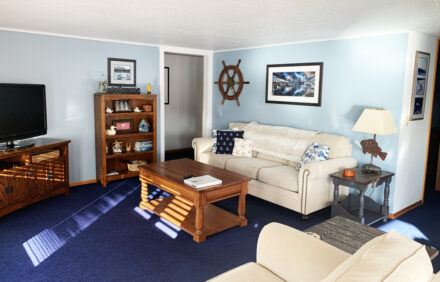Hiking in Ketchikan
Deer Mountain: Difficulty: Difficult Distance: 5 miles Elevation Gain: 2600 feet
Trail head at the end of Fair Street on the southeast side of town. Moderate hike. Recommended to pack rain gear. Excellent view of the ocean, mountain peaks around, local islands, and the forest. A longer hike to Blue Lake is available, additional 2.0 miles of moderate hiking which will give you a wonderful view of the lake and the local mountain peaks. Wildflowers and wildlife can be seen all along the trail in direction of Blue Lake.
Lower & Upper Silvis Lakes and Mahoney Mountain: Difficulty: Difficult Distance: 4-6 miles Elevation Gain: 3350 feet
Directions: From downtown Ketchikan, 13 miles south on Tongass Hwy until you dead-end into a gravel parking lot with dam-related out buildings.
- 2 miles one-way to Lower Silvis Lake (1.5 hours)
- 3 miles one-way to Upper Silvis Lake (2 hours)
- 6 miles one-way to Mahoney Mountain (6+ hours) 3300 feet elevation gain
Ward Lake Nature Trail: Difficulty: Easy Distance: 1.3 mile loop
Trail head 8.0 miles north of Ketchikan, off Ward Lake Road. Easy hike very popular on flat terrain. Picnic area and campground are available along the trail. Deer, beaver and red squirrel are commonly seen along the trail, as well as migratory birds in early summer in the lake. View of spawning salmon in late summer in Ward Creek; the lake and creek offer good fishing opportunities the entire summer season.
Ward Creek: Difficulty: Moderate Distance: 5 miles Elevation Gain: 100 feet
Located in the Tongass National Forest, Ward Creek is wide enough to drive a truck down, though no vehicles are permitted, and is popular with the locals for walking dogs. Across the road from the Ward Lake Recreation Area parking lot, trailhead 1 takes you north and follows Ward Creek, which flows out of Connell Lake, by the Last Chance campground, and through Ward Lake to eventually meet the ocean in Ward Cove.
Naha River: Difficulty: Moderate Distance: 6.5 miles
Trail head in Naha Bay or northwest end of Heckman Lake, 25 miles north of Ketchikan. Access is via float plane or boat. See local Ketchikan businesses. Easy to moderate hike. Features waterfalls and cascades, a saltwater lagoon offering excellent views of shorebirds and waterfowl, and a nice river offering good fishing for steelhead in spring and fall as well as Dolly Varden and cutthroat trout from spring to fall. There is a picnic shelter available and 2 cabins (fees for cabins) along the trail. Notes: Lots of local anglers use the lower river for fishing, especially on weekends. Solitude hikers can find quiet places in the upper trail part. Distance from Heckman Lake to Jordan Lake via the trail is only 2.0 miles.
Talbot Lake: Difficulty: Easy Distance: 1.6 miles
Trail head off Connell Lake Road, 3 miles east from the start of Ward Lake Rd. Moderate hike on boardwalk and gravel surfaces. Good forest and lake view. The trail ends on private property.
Salmon Walk: Difficulty: Easy Distance: 1.75 miles
In downtown Ketchikan, Trail head begins at the Visitor Center. Easy hike with lots of interests about the pulse of Ketchikan. Salmon viewing, nice stream following the town.
Nob Hill Walk: Difficulty: Moderate Distance: 1.5 miles
Trail head in town at Eagle Park on the waterfront. Moderate walk due to lots of steep stairs, plan 45 minutes to 1.5 hours. Interesting history of the town along the way and very nice view of the town on the hilltop.
Minerva Mountain Trail & The Carlanna-Perserverance Traverse: Difficulty: Difficult Elevation Gain: 2600 feet
If you are a lover of alpine, stunning views, and longer, more challenging hikes, then this all-day, one-way mountain traverse between Carlanna Lake and Perseverance Lake is the perfect choice.
Carlana Lake Trail: Difficulty: Easy Distance: 3 miles Elevation Gain: 150 feet
If you are looking for a shortish “in-town” trail, this trail begins at the back of a neighborhood and walks up a service road to a dam that overlooks a mountain-lake scene.
Perseverance Lake: Difficulty: Easy Distance: 2.2 miles Elevation Gain: 450 feet
Trail head 7 miles north of Ketchikan, off Ward Lake Road. Easy to moderate hike. Good scenery of lake, mountain backdrop and forest with some good fishing opportunities for rainbow trout in spring, summer and fall. Campgrounds are available near the Trailhead.
Whitman Trail: Difficulty: Easy Distance: 2 miles Elevation Gain: 200 feet
This hike offers a nice wide-open space experience and is not very long. Much like hiking the access road to Lower Silvis Lake, the Whitman Trail is another service road to two dams that generate electricity for Ketchikan residents and was recently made available for hiking and recreation; however, no motorized vehicles are permitted. Informative signs are posted on a fence gate up the road and on both dams.
Connell Lake Trail: Difficulty: Easy Elevation Gain: 100 feet
Connell Lake is a good choice if you want a trail that is less popular but just as close to town as the Perseverance trail. The rocky, dirt path gently climbs through the rainforest canopy and hugs the shoreline of the lake. On the other side is a nice flat area that the creek bows around, creating a small peninsula. A fire-pit indicates that this is a preferred spot to spend some time or camp.
Coast Guard Beach: Difficulty: Difficult Distance: 2 miles Elevation Gain: 170 feet
The one-mile gravel trail to Coast Guard Beach winds through Ketchikan Gateway Borough land and then crosses into Alaska Mental Health Trust Land. Mostly the trail descends to the beach; however, a few hills do rise along the way. This beach is a good place for walking, sunbathing, beachcombing, photography, writing, reading, meditation, tai-chi, just sitting, marine-life viewing, and dog swimming.
Dude Mountain: Difficulty: Difficult Distance: 3 miles Elevation Gain: 1500 feet
The drive out to the Dude Mountain trailhead is one of the most scenic drives that Ketchikan has to offer. The trail begins winding through lush rainforest. The last part is steep and can be muddy in wet weather or covered in snow in spring and fall.
Lunch Creek Trail: Difficulty: Difficult Distance: 10 miles Elevation Gain: 1300 feet
If you want to get away and don’t have a boat or a plane, this is as far away north one can easily get from Ketchikan. The trail ends at the headwaters of Lunch Creek — the shores of Lake Emery Tobin, which is surrounded by a rim of steep mountainsides often capped with snow ridges and peaks.
Lunch Falls Trail:
Leaving from the end of Tongass Highway, enter the Lunch Creek Trail and very soon take the trail to the left as this steps you quickly down to a waterfall viewing platform and then the rest of the way down to where, to the right, you can also cross the Lunch Creek bridge, which provides waterfall views as well as the ocean where the creek flows into.
Rainbird Trail:
Running just above and parallel to Ketchikan’s Third Avenue Bypass, Rainbird Trail is perfect if you only have a couple hours but still want to experience a small piece of Southeast Alaska’s rainforest. The trailhead is only a 20 minute walk from downtown (or a 5 minute drive), and the trail’s southern end—just beyond the top of the metal stairs—offers great views of downtown Ketchikan, the Tongass Narrows, and the neighboring islands beyond. Come on a Thursday in summer and you may catch an evening sailboat race followed by a brilliant sunset. In fact, Rainbird is one of the best locations to watch the sun sink low behind the mountains, illuminating the edges of town and the water in brilliant oranges, reds, pinks, and golds.
The original 0.6-mile trail was renovated as part of the UAS Rainbird Trailhead Improvement project in 2010. This cleaned up the overgrown northern end from the overpass to the UAS–Ketchikan campus, making it more accessible to the community.
Once you ascend the metal stairs on either end of the overpass and up the mountainside, the trail levels out and allows you a leisurely stroll through old growth rainforest. Despite occasional noises drifting up from the town, the forest’s protective cover gives you the sense that you’ve stumbled a true slice of the Alaskan wilderness. Midway through the trail, the forest opens up and you may hear calls from the ravens that occasionally alight on the branches of Sitka spruce. And take some time to enjoy the salmonberries and redcaps that grow on the southernmost and northernmost portions of the trail—they’re a delicious mid-summer treat!
Settlers Cove State Recreation Site:
Settlers Cove State Recreation Site offers two of the best sandy beaches to be found in the Ketchikan area and provides pit toilets and sheltered and unsheltered picnic tables with fire grates. A campground with eight campsites is available as well and one public-use cabin on the water that can be rented.
Rotary Beach:
Hear shrieks and squeals of excitement as kids wade around in tidepools with their buckets finding all manner of critters – eels, bullheads, snails, hermit crabs, sea urchins, sea anemones, starfish, blimmies (eel type fish), small octopus, eelgrass, clams, mollusks, and kelps.
Salvage Trail:
The Salvage Trail is an out-and-back trail that rolls up and down through the woods, paralleling Revilla Road. The trail is a wide gravel path where two-to-three people can walk beside each other.
South Tongass Waterfall:
On one of the run-off creeks from Achilles Mountain or Twin Peaks Mountain above pours a 100-foot or more waterfall right beside Tongass Highway towards the end of the road.
Refuge Cove State Recreation Site:
Refuge Cove State Recreation Site is a sliver of land lining part of an edge of a neighborhood and is a popular beach picnicking destination with the locals. The site comes complete with pit toilets, sheltered and unsheltered picnic tables with fire grates, and a quarter-mile trail accompanied by interpretive signs that address the local natural history.






